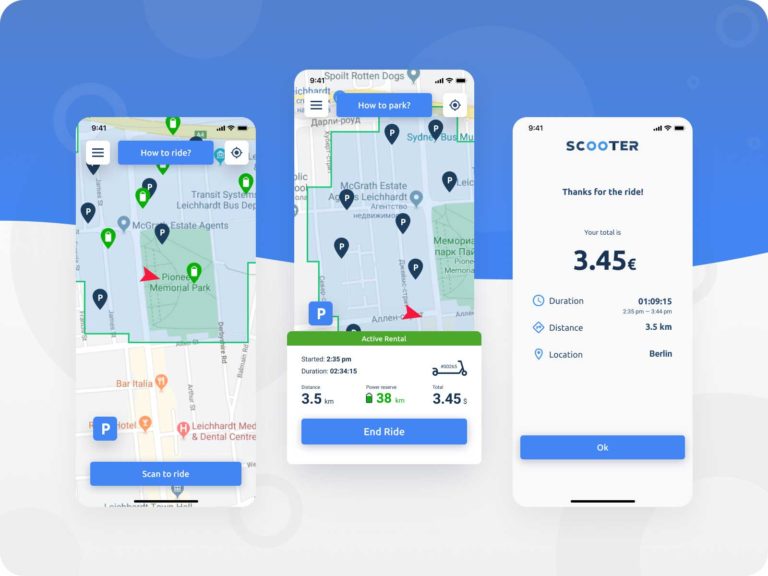E-Scooter Sharing Market: Insights, Trends, and the Best Services to Learn from
It’s hard to find a big European, Asian or American city without a scooter service. Many cities offer multiple services, and you can choose a scooter to your liking — usually, it doesn’t take long to find one. They’ve taken over the bike roads and people use them to get around instead of taxis — when the weather is fine of course.
Scooter sharing has become one of the most popular businesses you can launch — it’s popular, it’s clearly working, and there’s an electric scooter market and lots of unexplored territories still. Moreover, it’s much cheaper to launch compared to other similar services like car sharing for example.
Before you start your research on how to build a scooter-sharing app like Lime, for example, learn about the global market of electric scooters and build your strategy based on market prospects and hard data.
In this report, we’ll explore the scooter-sharing market, look at its driving factors and restrictions, and find out if it’s a good business model for the years to come.
Electric scooter sharing market analysis
In 2021, the scooter-sharing market was worth around $925.3 million and is now expected to grow with a CAGR of almost 18% between 2022 and 2032, according to Future Market Insights.
Other researchers like Fortune Business Insights expect the electric scooter market size to reach $31 billion by 2028 and grow at a CAGR of 10.7% between 2021 and 2028.
The popularity of using micro-mobility in a form of renting scooters is only going to rise in the following years according to the forecast, because of its convenience, low cost, accessibility, and mobile apps that facilitate the process of renting an e-scooter from the start to finish.
There are plenty of vendors that provide mobile app development services, and often they offer more than just development. For example, we at Mobindustry also recommend hardware and help prepare a working business plan for each individual e-scooter sharing project.
All these factors make the launch of an e-scooter sharing company easier than ever.
Electronic scooters are autonomous devices with swappable batteries that are rather lightweight and mobile, which makes their use and maintenance easy. Usually, they’re dockless, which is a great advantage compared to rented bicycles that users need to return to the nearest dock stations. A scooter can be left practically anywhere, which makes the pickup and parking process more convenient for the user.
COVID-19 insights
The COVID-19 pandemic locked the world inside, so for a long time, the demand for scooters rapidly plummeted. This affected the market and caused a hiccup in its stable growth.
The lockdown, however, wasn’t the only reason for the market decline: the disrupted shipping caused issues with scooter maintenance as well, as businesses couldn’t get enough parts for charging and fixing the scooters.
COVID-19 caused a hiccup in scooter sharing market growth, but since 2021 the industry has been experiencing rapid growth that is expected to only accelerate in the future
One of the major market players, NIU International, which delivers scooters for e-scooter sharing companies, reported having lost 40% of its revenue at the start of 2020 when the pandemic hit.
The market, however, has been recovering rapidly after the first vaccines were introduced, and governments lifted most of the restrictions. The scooter-sharing market is expected to quickly bounce back.
Scooter-sharing distribution channels
There are two main ways people use scooter services — online and offline. Offline scooter sharing services usually offer scooters at stations where they can be rented directly or via a phone call.
Offline scooter sharing only accounts for 5% of the market, but despite that, it’s in demand among the people who prefer the old ways. This segment of the scooter-sharing market is expected to grow at a CAGR of 12.5% between 2021 and 2028.
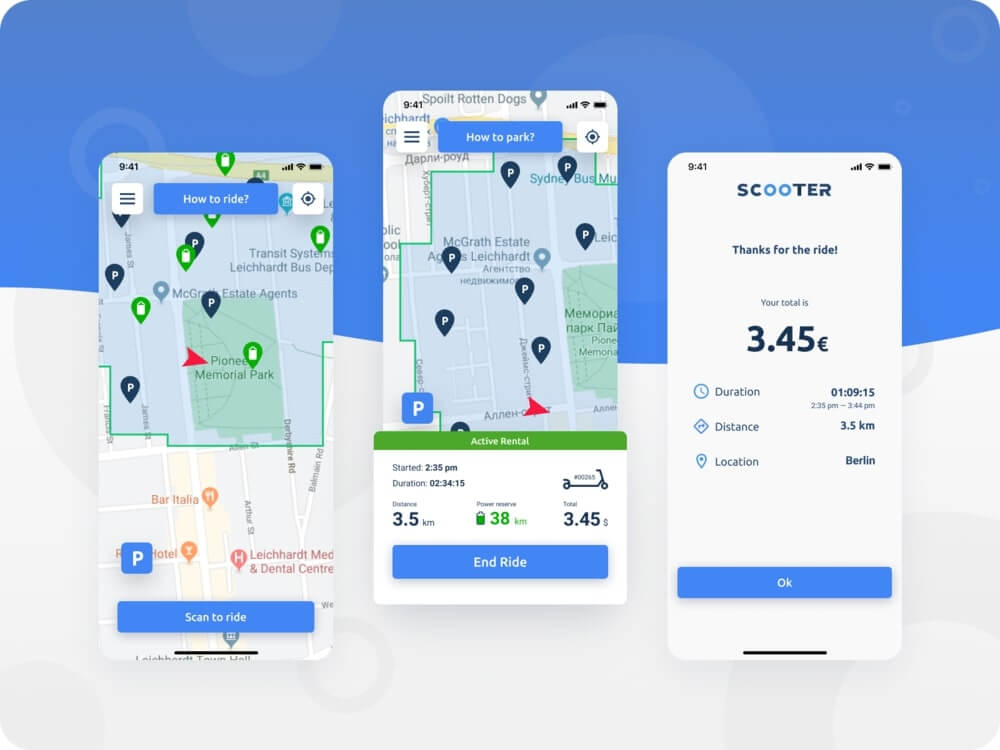
Online scooter sharing accounts for 95% of the market, allowing people to rent scooters via their mobile phones. Its expected CAGR is 19%. The modern audience expects everything to be on their smartphones, so naturally, most scooter-sharing services are built for mobile users. To use a service, a user needs to install a dedicated smartphone application and scan a QR code on any nearby scooter from a free-floating fleet.
Most popular regions for scooter sharing
Scooter sharing is popular all around the world, so you have many options when choosing your own target market for electric scooters. Here are the top 5 regions that have the largest scooter-sharing markets:
- North America
- Latin America
- Europe
- Asia
- The Middle East and Africa
The US and China are two leaders with the largest scooter-sharing markets in the world. The US scooter-sharing market is worth around $40 million, and is expected to reach $1.3 billion by 2032.
The Chinese market for scooter sharing was worth $70 million in 2021 and is projected to grow to $383 million by the end of 2032. The Chinese government enthusiastically backs up this market and is planning to invest over $2 billion in order to set up more charging stations and make China an even more attractive destination for e-scooter sharing companies.
According to the electric scooter market research, Europe is the third largest region in the world where over 65% of all scooter-sharing revenue is generated. Its growth is expected to be the most rapid in the world: compare its CAGR of 37.9% with that of North America (17.1%) and Asia Pacific (8.9%).
Top e-scooter sharing companies
Most of the scooter sharing market is divided by several key players that offer their services in different regions and are always looking for ways to expand their business to other countries and cities. Many of the larger players acquire their competitors or merge with them for mutual benefit.
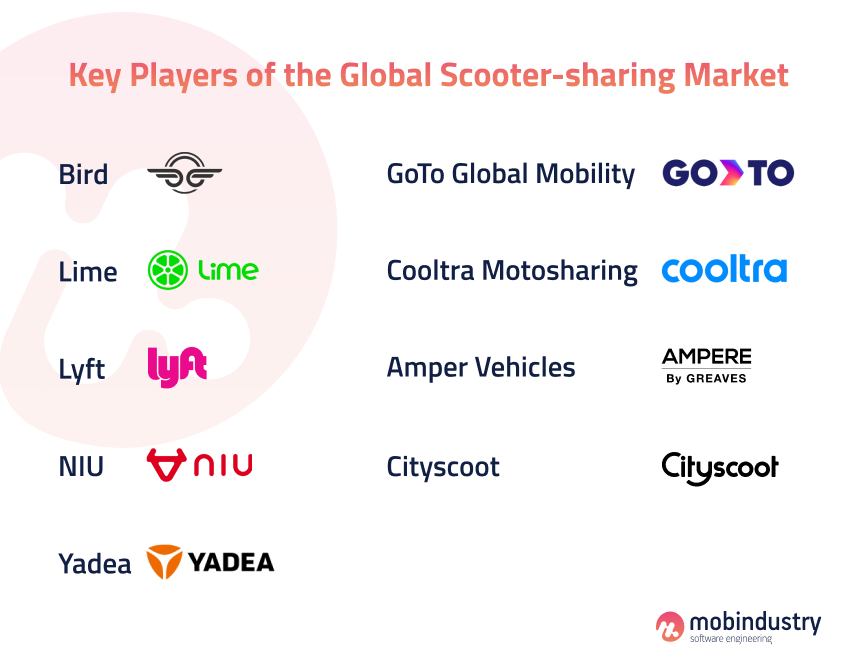
For example, in 2021, Neuron Mobility joined Lime in order to expand to New Zealand. In 2022, Ford sold their e-scooter sharing business called Spin to a German company Tier. This allowed Tier to expand to North America.
The most popular companies with the largest e-scooter market share are:
- Bird
- Lime
- Lyft
- GoTo Global Mobility
- Cityscoot
- Cooltra Motosharing
- Yadea
- NIU
- Amper Vehicles
These are the market leaders, many of these companies operate in multiple countries. For example, Bird is present in over 400 cities across the US and Europe.
The competitive landscape changes frequently, as new electric scooter-sharing companies arise, and older ones merge into larger businesses that constantly expand to new cities and countries.
Latest trends
The latest trend that drives the e-scooter market growth is the reduction of pollution and governments endorsing electric vehicles. For example, in 2019, India invested $100 billion to support all kinds of electric vehicles including scooters, and build the charging infrastructure for them.
The rising fuel prices in the face of the Russian-Ukrainian war are also pushing the market of EVs ahead, and people are choosing scooters to drive short-distance.
Driving factors
What makes scooter sharing such a popular business in most of the world? There are clear drivers of this market that are only becoming more significant with time. Let’s explore them.
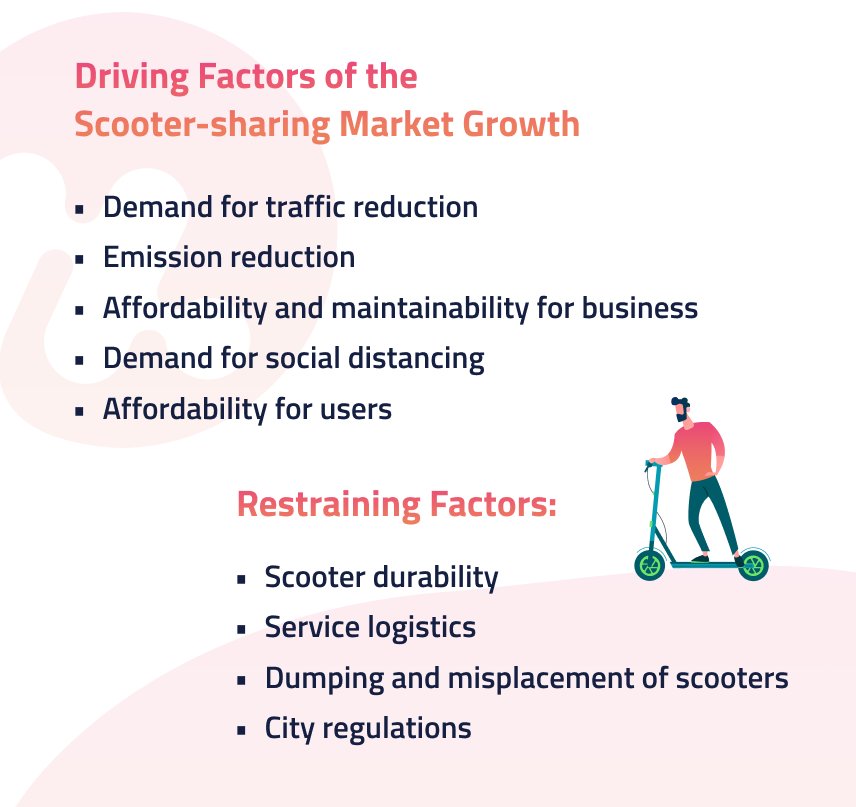
Demand for traffic reduction
Big cities are full of vehicles that constantly cause congestion, high traffic load, lack of parking spaces, and obstacles for emergency vehicles. Countries are trying to fight this issue in different ways, increasing the price of owning a vehicle and investing in ride-hailing solutions and public transport.
Scooter sharing is one of the ways to reduce traffic and allow people to get around the city without any public transportation or cabs. This significantly reduces the number of cars on the roads and replaces them with compact and highly mobile scooters that don’t take up much space and are mostly used on bike roads.
Emission reduction
Countries like China and India are actively investing in scooter-sharing businesses with the goal to reduce car emissions in their cities. Scooters are electric and thus produce zero emissions, which makes them a green alternative for short-distance traveling around the city.
Affordability and maintainability for business
To start a scooter-sharing business, you need to purchase scooters, create a mobile application and take care of the regulations. This is quite an affordable business compared to other types of ride-hailing businesses like car sharing.
The scooters themselves are comparatively easy to maintain and charge, so this also makes this business sustainable and profitable.
Demand for social distancing
After the COVID-19 pandemic e-scooters became even more popular despite the drop in their usage during the lockdowns. After some of the restrictions were lifted, scooters became a great way of transportation that wouldn’t involve people being in a closed space together, like in public transport.
Affordability for users
Using e-scooters is rather cheap for citizens, and it’s a great alternative to taxis and public transport for short-distance rides. For example, a Lime scooter costs $1 to unlock, and then a user is charged $0.15 per minute, which makes it much cheaper than taking a taxi for example.
Restraining factors for e-scooter sharing businesses
Although the e-scooter sharing business model is lucrative, this type of business has its specific challenges and restrictions. If you’d like to start a scooter-sharing business, you need to be prepared for these challenges before you invest in scooters and software for them.
Scooter durability
Although I mentioned that scooters are quite easy to maintain, heavy use still significantly reduces their durability — an average scooter lasts only three months of everyday use, so you need to have a separate budget for replacing the damaged or worn-out scooters.
The batteries for scooters are their main part, and they will also require constant maintenance and replacement, so you need to include this into your monthly expenses as well, and also set up a procedure for scooter replacement and maintenance.
Service logistics
If you’re planning to create a dockless scooter-sharing service, you’ll need to come up with a logistics plan for gathering your scooters from all the locations they were left in, so that you can charge them, swap batteries, perform necessary repairs and more.
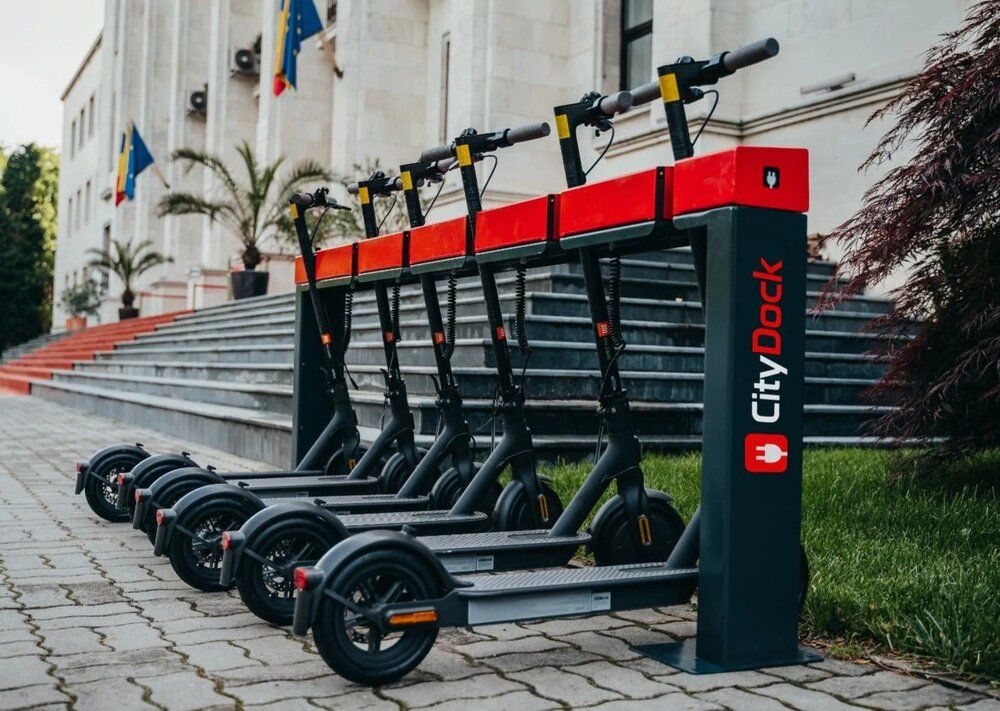
Then, your staff needs to again place the scooters everywhere they might be needed by your customers. Usually, this is done at night.
Dumping and misplacement of scooters
Your customers won’t always be responsible, and you’ll lose a number of scooters in places where they aren’t supposed to be. For example, in 2019, 57 scooters were picked up by divers from a Willamette river in Portland, US.
Any scooter-sharing business owner should be ready to replace some of the damaged or misplaced scooters, and also manage risks for public safety from misplaced or misused scooters.
City regulations
Most countries where scooters are popular, support such businesses, but at the same time, they strive to reduce accidents and ensure pedestrian safety. You as a scooter business owner should be aware of all city regulations and be able to navigate them.
Your service should warn users about the potential dangers of using scooters improperly and address any issues that may cause your users harm.
An owner of a scooter-sharing business should be ready for new regulations as well. For example, after governments all over the world noticed that scooter riders were harming people using the sidewalks, they banned scooters from sidewalks altogether.
The best services to learn from
Bird
Bird has been operating since 2017, and it started small, in California. In 2022, people from over 100 cities in North America, the Middle East, and Europe use its scooters for getting around.
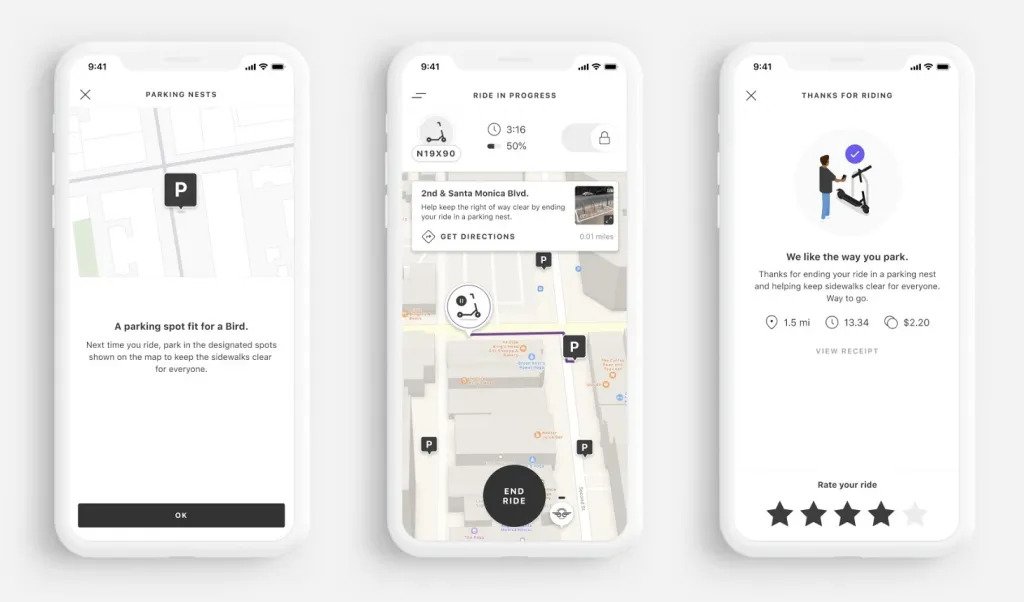
Throughout the years, Bird managed to raise hundreds of millions of dollars and acquired other scooter-sharing companies to expand their operations in places where dockless sharing programs are approved.
Lime
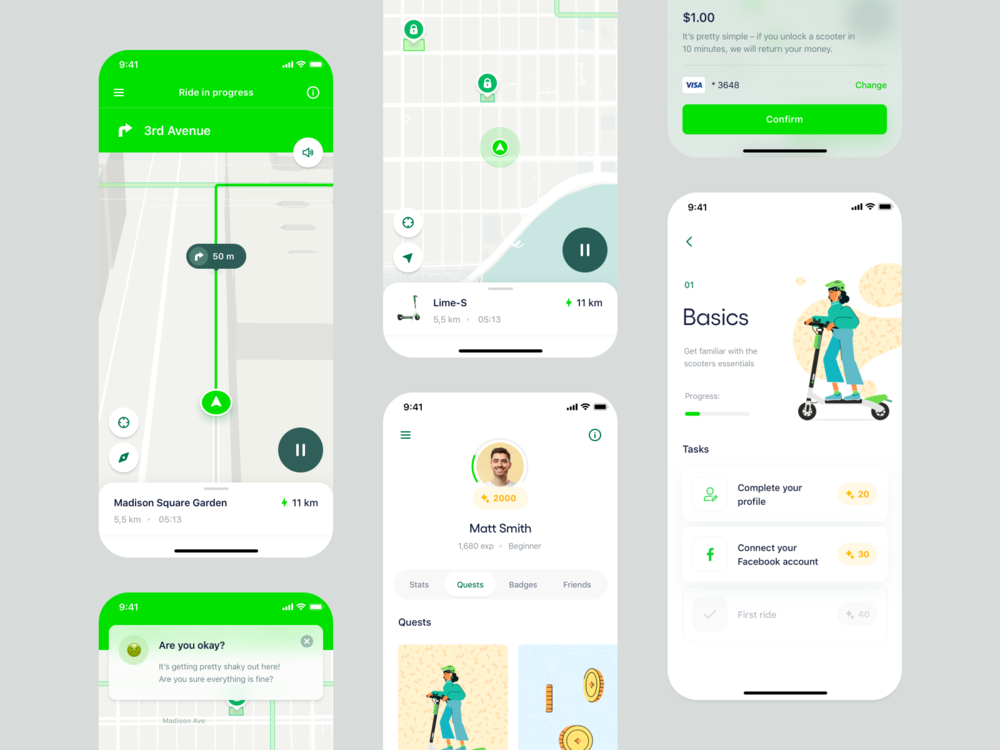
Just like Bird, lime has been around since 2017, and the vehicles it offers to customers don’t stop at scooters — Lime users can enjoy electric bikes, pedal bikes, mopeds, and cars to get around hundreds of cities around the world.
Currently, Lime is working in a partnership with Uber — users can rent a Lime scooter through an Uber app. In 2022 Lime is present in over 150 cities across 30 countries.
Bolt
Bolt is a taxi service like Uber, that also offers food delivery services, car-sharing, and of course scooter sharing services. It was founded in Estonia in 2013, and today people from over 500 cities across 45 countries in the world can enjoy its services. Bolt operates in Europe, Africa, Latin America, Western Asia, and other locations.
Currently, Bolt has over 100 million users globally, and its user base, as well as location coverage, is expanding constantly. The scooter-sharing services are available in Bolt’s taxi application.
Veo
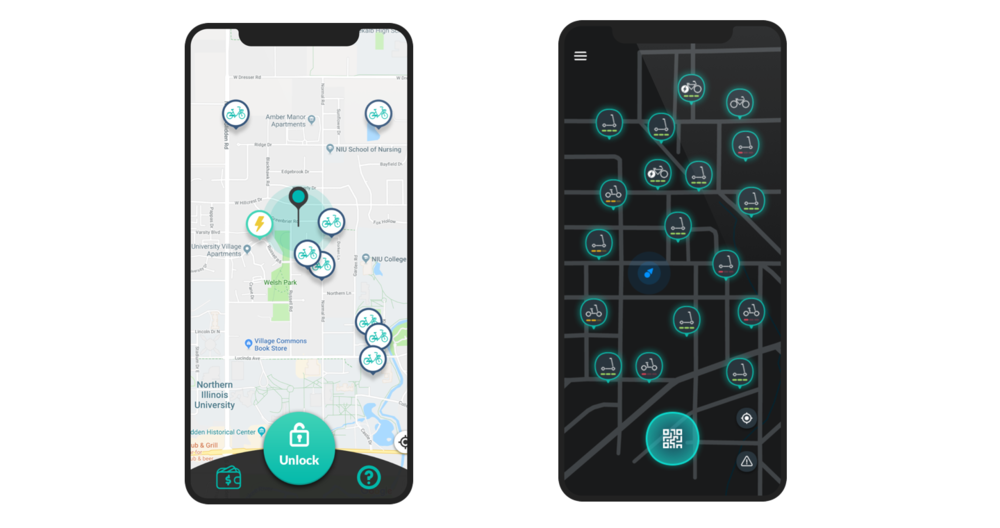
Unlike Bolt or other companies I mentioned above, Veo isn’t as geographically diverse. However, their selection of electric vehicles is something to consider for your own scooter-sharing business, if you’d like to stand out from the crowd of competitors.
Veo offers everything from traditional scooters to e-bikes, pedal bikes, seated scooters, and more. Their application is great, and users enjoy high-quality vehicles. Veo operates in 15 states in the US, and plans further expansion.
Final thoughts
Scooter sharing is a market with great prospects for the upcoming years. It’s becoming more popular across the world, and governments are investing in infrastructure and startups to fight traffic congestion and greenhouse gas emissions.
Most scooter-sharing businesses operate in large cities in North America, Europe, Asia, and the Middle East — these are the largest market for micromobility businesses.
The crisis of COVID-19 has tampered with the growth of such businesses at the time, but they’re recovering quickly and are expected to grow even faster due to the rising gas prices and the strong demand for electric vehicles.
If you’re interested in creating your own e-scooter-sharing business, make sure to contact us: we have experience in e-scooter app development, and will help you pick the right, cost-effective equipment for your scooter-sharing startup as well.


